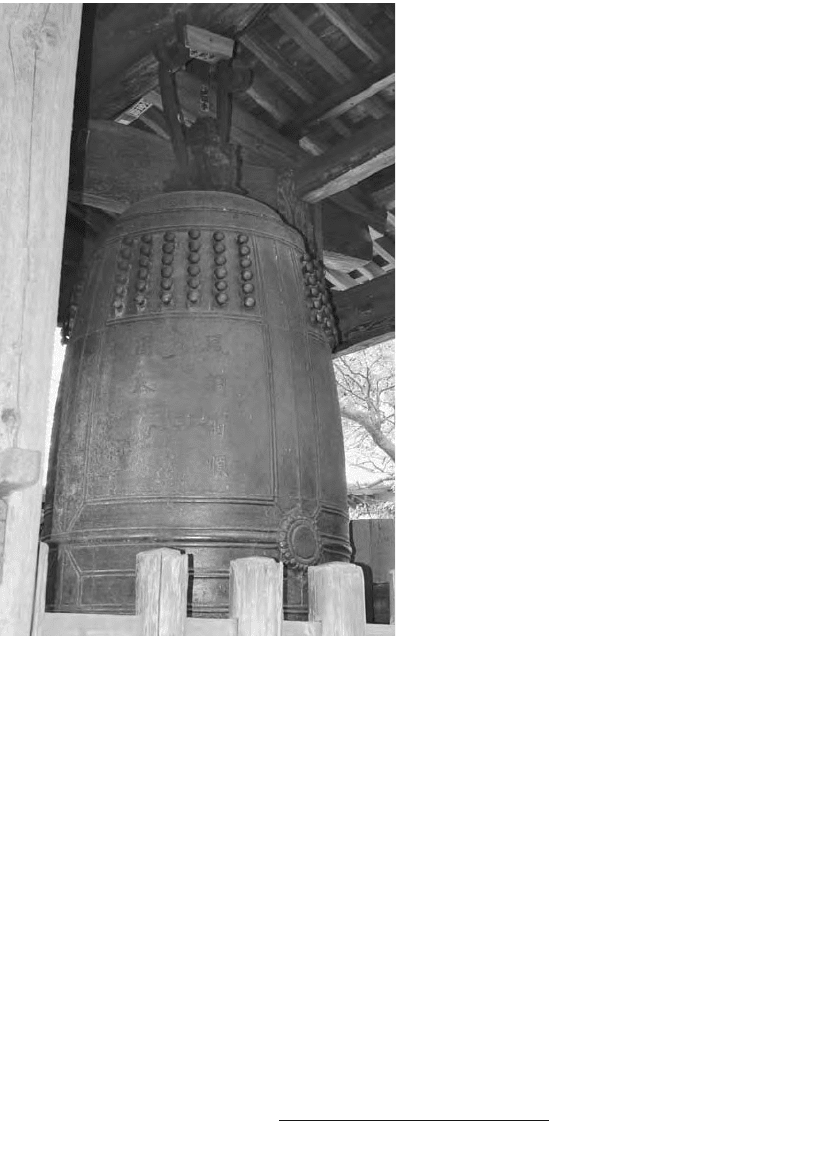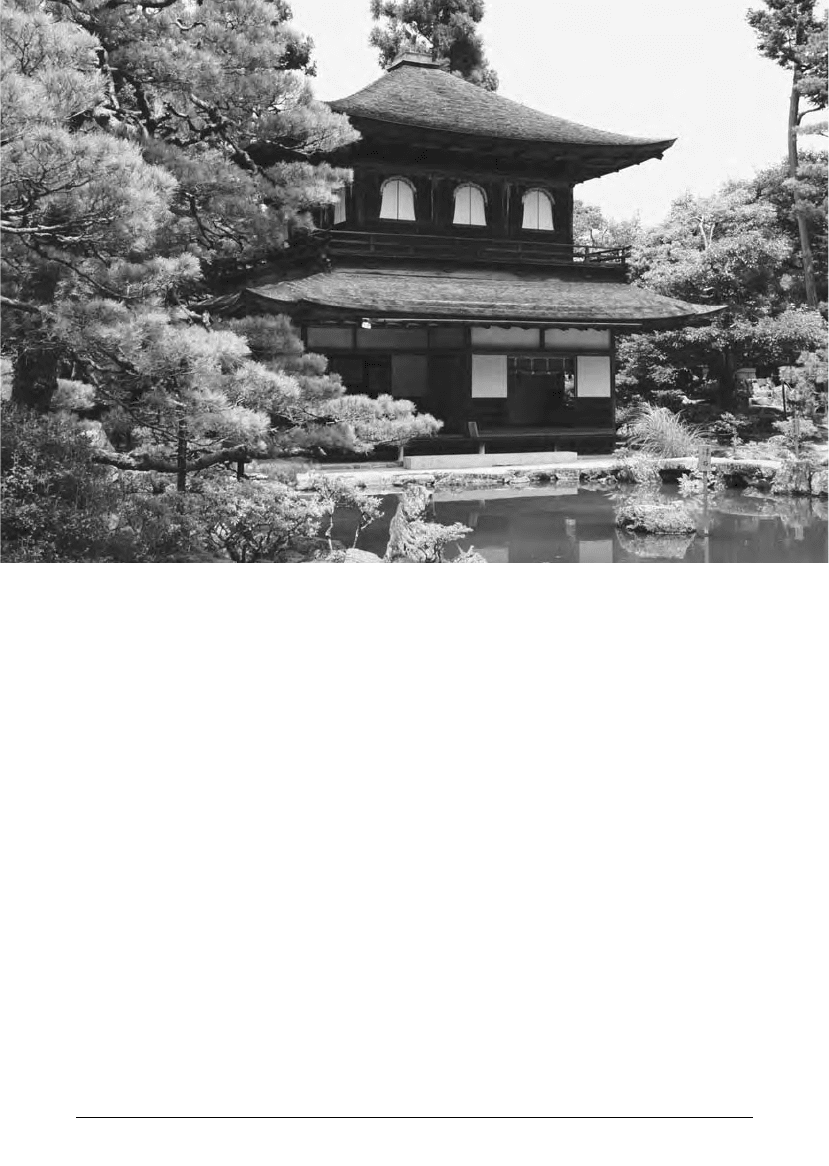Deal W.E. Handbook To Life In Medieval And Early Modern Japan
Подождите немного. Документ загружается.


both concepts integral to later tea aesthetics. So fig-
ural were these terms that the understated aesthetics
of Murata Shuko, and his heirs Takeno Joo and Sen
no Rikyu, became known as wabi tea to distinguish
them from more ostentatious tea preparations
favored by the feudal lords.
In addition to contributing to a philosophy of
tea, Shuko also influenced tea architecture through
his service to Ashikaga Yoshimasa. At the eastern
Kyoto villa today known as Ginkakuji, Shuko hosted
tea gatherings on behalf of Yoshimasa that took
place in a room designed with only four and a half
tatami mats. These mats consisted of woven grass
covering a thick filling of rice straw. The configura-
tion and number of tatami used by Shuko in this
intimate tea setting later became a standard format
for tearooms.
Sen no Rikyu (1522–91) formalized tea ideals
first articulated by Murata Shuko. However, Rikyu
was more influential than Shuko both in terms of
access to prominent tea patrons and adherence to
tea sensibilities that typified Zen austerity and
understatement. During his merchant upbringing in
the prosperous port city of Sakai on the eastern
Inland Sea, Rikyu was exposed to continental
imports such as tea ceramics that appealed to
wealthy Sakai merchants, whose patronage and cul-
tural aspirations fueled new currents in tea aesthetics
from the late Muromachi era to the 17th century.
Further, Rikyu studied with Takeno Joo (1502–55), a
Sakai-based Zen priest, poet, and tea aficionado who
first followed the teachings of his teacher, Shuko,
and then strove to improve upon them later in his
career. Joo eventually exercised considerable influ-
ence, for he possessed a sizable and enviable collec-
tion of tea utensils, and his innovations were carried
as far as Kyoto.
Rikyu, a student of Joo, grew to prominence in
this environment, where he was particularly note-
worthy for his pursuit of the wabi aesthetic. Rikyu
followed both of his predecessors in the way of tea,
as he too harbored a profound appreciation of
wabi—purity and harmony expressed in the humble
appearance of the rustic tearoom and related tea
objects, as well as the uncomplicated allure of aus-
terity and restraint. As noted earlier, wabi has been
an especially figural sensibility in tea culture,
although it is somewhat incomplete unless paired
with its aesthetic complement, sabi, which evokes
the loneliness and quietude of age, as well as the nat-
ural tarnish and worn surfaces that can be acquired
only through time and frequent use.
As Oda Nobunaga (1534–82) ascended to power
in the late 1560s, he summoned Rikyu to serve as
his tea officer and cultural adviser. After Nobuna-
ga’s assassination in 1582, Toyotomi Hideyoshi
followed his former general both in unifying Japan
and engaging Rikyu. Both Nobunaga and Hide-
yoshi recognized the importance of tea and re-
lated arts in military culture and enjoyed the
heightened political and cultural supremacy Rikyu
conferred through his status as highest authority of
the wabi tea tradition. Although officially a cultural
adviser, Rikyu could serve as social agent, go-
between, or even diplomat, thus intervening in var-
ious delicate political contexts even while reflecting
favorably upon the cultural acumen of his overlord.
Further, Nobunaga and Hideyoshi had acquired
coveted tea implements originating in the Ashikaga
collections. Armed with the bounty of their con-
quests, these military lords demonstrated to con-
quered daimyo tea enthusiasts that they had
supplanted the old regime, yet appreciated its cul-
tural heritage.
Soon after achieving his goal of unifying Japan,
Hideyoshi ordered Rikyu to commit seppuku, or rit-
ual suicide, in 1591 for reasons that remain unclear.
Despite his demise, aspects of Rikyu’s taste and
ideals persisted in tea practice amid the sweeping
cultural changes of the Edo period.
Tea rituals became less exclusive and tea masters
grew more accessible as Rikyu’s grandson, Sen Sotan
(1578–1658) and his three heirs, Soshitsu (1622–97),
Sosa (1619–72), and Soshu (1593–1675), founded
schools and established publications to disseminate
tea traditions. Initially, daimyo patronage domi-
nated, but later adherents grew to include samurai,
artisans, merchants, and other commoners. Some of
Rikyu’s innovations helped to further the broad
access to tea that characterized the Edo period. For
example, in a break with prior protocol, Rikyu had
stipulated that tea should be made in front of guests,
rather than prepared in one room and later served in
another. Practices such as this fostered the egalitar-
ian image of tea projected by Rikyu descendants
who formed the Urasenke school, a tradition aimed
H ANDBOOK TO L IFE IN M EDIEVAL AND E ARLY M ODERN J APAN
304

at attracting more humble members of society to tea
practice. The ascetic spirituality of medieval Bud-
dhism that suffused the wabi style of tea most closely
connected with Rikyu began to fade as tea patronage
shifted from wealthy merchants and ambitious mili-
tary lords to peacetime samurai who favored a style
sometimes described as “daimyo tea.”
Despite his significant political and spiritual con-
tributions, Rikyu most affected tea and related arts
through his exacting connoisseurship—enabling
him to identify tea utensils that embodied his ideals
of restraint, simplicity, and directness. Although
Rikyu’s greatest legacy may be his exquisite sense of
design and discernment, subsequent generations
have credited him with numerous other achieve-
ments. Principles of tea ascribed to Rikyu codified
by his great-grandsons in the Edo period propose
that he established the four ideals of tea captured in
the Japanese characters wa (harmony), kei (respect),
sei (purity), and jaku (tranquility or natural ele-
gance). Below, these concepts are presented in terms
of the role and relevance of each term in the world
of tea ritual.
harmony (wa): a desire for reciprocity, both at the
tea gathering and in the outside world
respect (kei): awareness of one’s individual role and
responsibilities, and appropriate decorum
purity (sei): a commitment to preserve social and
spiritual integrity
tranquillity or natural elegance (jaku): savoring the
transient moment to gain renewal
Tea Preparations
The host’s procedure for preparing tea (temae)
demonstrates both economy of motion and grace.
Each action flows into the next in a measured, seam-
less choreography interrupted only by periodic taps
and flourishes that punctuate stages of preparation.
Typically, the temae involves six basic steps:
1. All tea implements, except the iron water kettle,
which is usually placed on the hearth or brazier
before the guests enter, are carried into the tea-
room and arranged.
2. The host purifies the tea container (natsume or
chaire) and bamboo tea scoop (chashaku) by wip-
ing them with a silken cloth (fukusa).
3. Hot water poured into the tea bowl (chawan)
warms both the bowl and bamboo tea whisk
(chasen).
4. Using the bamboo tea scoop, the host places
powdered green tea in the bowl. Hot water is
added to the tea and whisked until the texture is
frothy.
5. After guests have enjoyed their tea, the bowl and
whisk are cleaned along with the tea scoop.
6. The host withdraws from the tearoom, returning
all implements except the kettle to the prepara-
tion room.
Typical tea gatherings conclude as the host passes
tea utensils for guests to appreciate and inspect. Ful-
filled by the tea and atmosphere of camaraderie,
guests leave the gathering refreshed by their shared
experience.
Tea Utensils (chadogu)
Hanging Scroll (jiku) When entering the tea-
room, guests should approach and honor the
scroll first, by bowing. Unlike many of the imple-
ments, the scroll is not part of the process of
preparing tea. Still, the jiku is essential to the tea
gathering, and may be the most revered object in
the tearoom. Scrolls may feature painted images,
although calligraphic works are also favored.
Mounted on backings made of textiles attached to
a dowel to facilitate storage, jiku are placed in the
tokonoma, an alcove reserved for displaying scrolls,
flower arrangements, and sometimes an incense
container. Scrolls are also known as kakejiku or
kakemono.
Flower Container (hanaire) Flowers for tea are
arranged to appear as if still growing in the fields.
The flower container, or hanaire, is selected to suit
the buds, blossoms, and/or grasses, to harmonize
with seasonal themes, and to complement the tea-
room itself. Hanaire may be bronze, copper,
ceramic, or bamboo.
A RT AND A RCHITECTURE
305

Tea Kettle (kama) The kama comes in many sizes
and shapes. Larger kettles are placed on the ro (fire-
place or hearth) and smaller versions are placed on
the furo (brazier). In chanoyu, the kettle is used to
boil water, not to steep tea, as in many other coun-
tries. There are many shapes of kettles, and although
they are usually made of iron, kama are also crafted
from gold or silver.
Portable Brazier (furo) The furo is a portable bra-
zier that is used for ceremonies from May to Octo-
ber. Furo are made of earthenware, bronze, iron,
wood, and other ceramic materials. During the win-
ter, the tea kettle is heated on the fireplace or hearth
(ro) itself. An iron furo is always placed on the shiki-
gawara (fire tile).
Fresh Water Jar (mizusashi) This covered jar
holds cool water used to regulate the temperature of
the water in the kama or to rinse certain utensils.
While mizusashi are ceramic, wooden or metal jars
are also used.
Tea Caddy (chaire and natsume) The chaire is
a type of tea caddy used for thick tea and the nat-
sume is used for thin tea. Chaire are kept in shifuku
(small silk bags). A chaire is usually ceramic and has
an ivory lid. Natsume may also be called usuki or
chaki.
Tea Scoop (chashaku) Crafted from various mate-
rials ranging from ivory to bamboo, the chashaku is
used for scooping powdered tea from the caddy into
a tea bowl.
Teabowl (chawan) The teabowl plays a central role
in the art of chanoyu as the link between host and
guest. Made in a wide variety of sizes, shapes, and
types, chawan are selected by the host to express the
degree of formality of the occasion, seasonal prefer-
ences, and contemporary sensibilities.
Lid Rest (futaoki) for the Tea Kettle and Water
Ladle There are seven kinds of famous futaoki
selected by noted tea master Sen no Rikyu (1521–
91). Each has its own specific rule for use. In gen-
eral, however, the most common futaoki is a small
bamboo mat.
Bowl for Waste Water (kensui) Water used to
rinse utensils is discarded in this bowl. Kensui are
sometimes called koboshi.
Water Ladle (hishaku) There are many types of
hishaku, defined by the cut of their handles. Those
that have handles cut from the outside diagonally
may only be used with a ro (winter tea). Those with a
handle cut from the inside diagonally may be used
with the furo (summer chanoyu).
Bamboo Whisk (chasen) Chasen are made of dif-
ferent types of bamboo. Some examples of materials
used to make tea whisks include smoked and dried
bamboo. Participants from different schools of tea
prefer certain types of tea whisks.
Tea Cloth (chakin) This piece of linen—used to
wipe tea bowls—measures about a foot long and five
inches wide.
Role of Nature in the
World of Tea
Chanoyu involves both social and religious princi-
ples. However, appreciation of nature is also a cen-
tral component of preparing and enjoying tea in
Japan. Shinto and Buddhism have long coexisted in
Japan, and both religions also incorporate profound
regard and respect for the natural world. The Shinto
tradition proposes that sacred beings (kami) are
manifest in nature. According to Shinto, kami may
reside in rivers, rocks, mountains, or even trees. Tea
utensils, architecture, and related art forms favor
undecorated surfaces and rough or weathered tex-
tures that highlight nature’s beauty, just as these ele-
ments are prized in Shinto rituals and sanctified
Shinto sites. As in Shinto practice, purification also
has a vital role in tea gatherings. Buddhists have
established perspectives on the import of the natural
world, which is a reminder of the transience of
human existence. Buddhism celebrates this belief
through heightened awareness and acceptance of
seasonal changes and other temporal rhythms.
Monks are trained to meditate through concentra-
H ANDBOOK TO L IFE IN M EDIEVAL AND E ARLY M ODERN J APAN
306

tion on the present moment, without regret for the
past or desire for the future, and thereby attain
release. Similarly, chanoyu urges participants to cher-
ish the fleeting beauty of nature’s cycles while shar-
ing a bowl of tea and quiet conversation in natural
surroundings. In addition, most tea wares reflect
Buddhist preferences for economy of design and
subtle decoration.
Tea Ceramics
Ceramics for use in tea gatherings have been care-
fully selected to echo the rustic setting and under-
stated pleasures central to the way of tea. Initially,
ceramics used for preparing and enjoying tea were
Chinese and Korean objects imported by monks and
art enthusiasts, especially during the late Kamakura
and Muromachi eras. Soon, Japanese potters began
to craft wares emulating these imported ceramics,
and some ceramicists emigrated from China and
Korea, thus transmitting ceramic production tech-
niques and types directly to artisans working in the
Japanese archipelago.
While various tea traditions espouse particular
aesthetic sensibilities regarding ceramic types for tea
preparations, many schools agree on the most desir-
able varieties of ceramic wares for the tea bowl.
Raku ware, Karatsu ware, and Hagi ware are all
ceramic types favored for tea bowls. However, other
varieties, such as Shino, Seto, and Oribe wares, are
also frequently used. Regardless of its origin, the tea
bowl has a special role in tea preparation as the tea
implement that is handled the most, and the object
that best embodies the desired connection between
the host and guest.
ARCHITECTURE
There are at least two ways in which the study of
medieval and early modern architecture might be
organized: temporally—in sequential order from
style to style—and functionally—buildings typed as
religious or secular. Both these approaches seem
commonsensical, but both also introduce particular
difficulties with regard to architecture in medieval
and early modern Japan.
In the temporal approach, for instance talking
about “medieval” or “early modern” architecture,
there is a need to account for the fact that temples
and shrines might be constructed in one period but
have additions or other stylistic changes made to
them over the centuries. Initially, a structure might
be constructed in one style but come to reflect the
accretion of multiple styles belonging to different
time periods. Similarly, shrine and temple buildings,
despite the vagaries of weather, fire, and other nat-
ural predators of wood construction, sometimes
endured over the centuries and were important in
multiple time periods, their architectural styles a
part of periods far removed from their original time
of construction. In at least one famous instance—the
Ise Shrine—the architectural style is very old but the
shrine buildings are rebuilt every 20 years as a means
of ritual purification. Hence, the buildings are
always new but exhibit an old architectural style.
The distinction between religious and secular
architecture is also fraught with problems and ambi-
guities. Some architectural forms, such as the Shoin
style (see below), were derived from both Buddhist
and aristocratic sources. Secular retirement villas
might be turned into Buddhist temples, as in the
case of Kinkakuji and Ginkakuji (see below). The
blending of the religious and secular was not unique
to Japanese architecture, but was rather indicative of
a worldview that did not make sharp distinctions
between the sacred and the profane. While temporal
and functional categories are suggested below, they
should not be treated as definitive categories for
organizing medieval and early modern Japanese
architecture.
Buddhist Architecture
Buddhist architecture refers to building styles asso-
ciated with temples and temple complexes. Buddhist
temple complexes consisted of multiple structures
functioning in concert to create a contained com-
munity that met both the spiritual and material
A RT AND A RCHITECTURE
307

needs of those residing there. Fundamentally, tem-
ples were places dedicated to a variety of Buddhist
practices and functions. Different buildings were
constructed for these different functions. Temple
compounds had buildings for worship of the Bud-
dhas and bodhisattvas, dwellings for monks or nuns,
halls for religious training and practice, and also
places to house texts and other important religious
objects. In most cases, temples also served as gather-
ing places for members of the laity.
Prior to the medieval period, there had been
ideas about the proper number and configuration of
buildings for a Buddhist temple complex. However,
by the Kamakura period, temples were typically
designed according to one of three different styles,
or in a style combining the three. Thus, not all tem-
ples were designed in the same way or with the same
layout of buildings and grounds, and different Bud-
dhist schools utilized different configurations.
STYLES OF BUDDHIST
ARCHITECTURE
Styles of Buddhist architecture changed over the
centuries. In general, they were a combination of
both Chinese and indigenous Japanese styles. In the
medieval period, the preexisting Japanese style
(wayo) of Buddhist architecture was used, along with
two new important Buddhist architectural styles
first developed in the early medieval period: the
Great Buddha style (daibutsuyo) and the Zen or Chi-
nese style (karayo). By the end of the Kamakura
period, temple construction started to borrow from
the different Buddhist architectural styles to create
a hybrid or eclectic style (setchuyo) that utilized ele-
ments from the Japanese, Great Buddha, and Zen
styles. While use of the three main architectural
styles continued in the early modern period, a
fourth style—Obaku style—was imported from
China and was primarily associated with the Obaku
Zen school.
One of the distinguishing characteristics of Bud-
dhist architecture generally is the style of bracketing
used to support the roof and eave of a temple on the
outside of a building and the ceiling on the inside.
Bracketing served both structural and aesthetic
functions. Different Buddhist architectural styles
used different bracketing systems and thus bracket-
ing became one of the architectural features that set
different styles apart from each other.
Japanese Style (wayo) In its use as an architectural
term, wayo or Japanese style refers to the style of
Buddhist architecture current in Japan beginning in
the Nara period. Despite the term, Japanese style is
in fact the overlay of Japanese architectural styles—
such as the use of unpainted and untreated wood,
simple ornamentation, and curved lines—over styles
imported from Tang-dynasty (618–906) China.
Once Tang-style architecture was introduced to
Japan, it evolved into a Japanese style throughout
the course of the Heian period. The term wayo was
created in the early medieval period to contrast the
older architectural style with new styles then becom-
ing prevalent, imported from the Asian mainland.
Although Japanese-style Buddhist architecture
was largely supplanted in the Kamakura period by
new styles, it was nevertheless employed in some
important temple rebuilding projects. Of particular
note was the use of Japanese style to rebuild struc-
tures at two Nara temples, the Kofukuji and the
Todaiji, that were destroyed during the Gempei
War.
Great Buddha Style (daibutsuyo) or Indian Style
(tenjikuyo) The Great Buddha style (daibutsuyo) of
Japanese Buddhist architecture is also referred to as
Indian style (tenjikuyo). The term tenjikuyo was used
in the medieval period; daibutsuyo is a modern term
coined to more accurately describe this aspect of
Japan’s architectural history. Although tenjikuyo
means “Indian style,” this architectural style actually
makes no visual reference to Indian design modes.
Rather, it refers to south China architectural style
blended with traditional Japanese design features.
The term daibutsuyo was named after the style of
the Todaiji Great Buddha Hall (daibutsuden) when it
was rebuilt through the efforts of the priest, Chogen
(1121–1206), who had introduced Indian style to
Japan after returning from his travels in southern
China during the Song dynasty. The Great South
Gate (nandaimon) at Todaiji, designed by Chogen
and built at the same time as the Great Buddha Hall,
is an important example of the Great Buddha style
still extant. Chogen’s Great Buddha Hall construc-
tion burned in 1567 and was later rebuilt in a similar
H ANDBOOK TO L IFE IN M EDIEVAL AND E ARLY M ODERN J APAN
308

style. Use of the Great Buddha style was largely
abandoned soon after Chogen’s death, though some
of its details and elements were incorporated into
other architectural styles.
Zen Style (zenshuyo) or Chinese Style (karayo)
The Zen style (zenshuyo) of Buddhist architecture
was imported from China during the Kamakura
period. An important extant example of this style is
the Relic Hall (shariden) at the Engakuji constructed
in the medieval period in the city of Kamakura. The
Zen style, as an architectural term, is a modern
coinage. The term used during the medieval period
was Chinese style or karayo, reflecting the importa-
tion of this style from Song-dynasty (960–1279)
China. As the name implies, the Zen style was par-
ticularly associated with design elements used for
building Zen temple complexes in the medieval
period.
The Zen style introduced new design elements
into the construction of temples. Among these inno-
vations were novel styles of ornamentation, up-
wardly curved fan rafters, and bell-shaped windows.
Although Zen style was based on Chinese models,
Japanese designers innovated on the borrowed
design to create an architectural style different from
its Chinese counterpart. The roof structure, for
instance, was modified to meet Japanese practical
and aesthetic needs.
Obaku Style The Obaku style of Buddhist archi-
tecture was introduced to Japan in the late 17th cen-
tury and is associated with Zen temples belonging to
the Obaku school. The Obaku school of Zen Bud-
dhism was imported from China to Japan in the
middle of the 17th century. The Mampukuji in Uji
(south of Kyoto), constructed in the 1660s, exempli-
fies the Obaku style. The Obaku architectural style
uses traditional Zen features, but also incorporates
design elements from Chinese Buddhist architec-
tural forms of the late Ming (1368–1644) and early
Qing (1644–1912) dynasties, including the physical
layout of the temple grounds. Among the Chinese
architectural innovations apparent at Mampukuji
and other Obaku temples are such features as open
corridors running between temple buildings, a four-
tiered bracketing system, intricately carved pillar
base stones, and decorative railings.
BUDDHIST COMPLEXES
AND BUILDINGS
Typical kinds of buildings and structures found at a
temple complex—besides those for everyday func-
tions such as kitchen, dining hall, dormitory, bath-
house, and latrine—included those in the following
list. Note that not all temple complexes necessarily
had all of these kinds of buildings and structures,
and some may have had variants of these buildings,
depending on the particular Buddhist school.
main hall (kondo or hondo or butsudo or butsuden
or Amidado) The location of a temple’s most
important images of Buddhas and bodhisattvas. The
term kondo (golden hall) was used particularly in
the Nara and Heian periods. Although the term was
also used during the medieval and early modern
periods, the term hondo (main hall) became much
more widely used to refer to a temple’s main hall.
The term butsudo (Buddha hall) is a generic term for
a main hall housing a Buddha image. The term but-
suden (Buddha hall) refers to the main hall at a Zen
temple. The term Amidado refers to the main hall at
a Pure Land temple.
lecture hall (kodo or hatto) The term kodo refers to
a lecture hall used by Buddhist schools other than
Zen. Buddhist statues are usually placed inside the
kodo, and the lecturing priest stands in front of them.
The term hatto (literally, “Dharma Hall”) refers to
the lecture hall at a Zen temple. Typically, Buddhist
imagery is not used in a Zen lecture hall.
meditation hall (zendo) A Zen temple meditation
hall used especially for the practice of zazen, or
seated meditation.
pagoda (to) The Buddhist structure known as a
pagoda (to; literally, “tower”) was, in Japan, usually a
wooden, multitiered structure that housed relics of
the historical Buddha’s bodily remains. The pagoda
form and function originated in Indian Buddhist
architecture where the stupa, as it was called in San-
skrit, was a hemispherical dome made of earth and
stone. The stupa became formalized into the East
Asian pagoda, a much taller and narrower structure
made of wood. Both stupas and pagodas are crowned
A RT AND A RCHITECTURE
309

with a spire. According to early documents, the
pagoda as a central feature of important Buddhist
complexes was introduced to Japan by the end of the
sixth century.
sutra repository (kyozo) A text repository housing
Buddhist scriptures and commentaries as well as
temple documents
bell tower (shoro) Housing for the temple bell that
was rung to mark specific ritual occasions or other
events
gates (mon) Buddhist temple gates functioned to
set apart the temple grounds from the outside world.
Gates within a temple complex created spaces within
the larger temple grounds that were set apart as espe-
cially sacred or ritually important. Temples were
sometimes divided according to an inner and outer
precinct demarcated by a gate. Some gates could be
quite large and imposing, signifying the importance
and power of a particular temple complex.
ARCHITECTURE UNDER THE
ASHIKAGA SHOGUNS
Two Muromachi-period pavilions that attest to the
pervasive influence of Zen Buddhism also reflect
the seamlessness of secular and religious culture
under the patronage of the Ashikaga shogunate
(1333–1573). Originally constructed as villas for
retirement, these two structures are known today
as Kinkakuji (Temple of the Golden Pavilion; ori-
ginally Rokuonji) and Ginkakuji (Temple of the Sil-
ver Pavilion; originally Jishoji), although the
buildings were not converted into temples and given
their present names until after the deaths of their
owners.
The third shogun, Ashikaga Yoshimitsu, de-
monstrated his passion for Chinese visual and
literary arts when he ordered his three-story, dou-
ble-roofed pavilion constructed in the Kitayama
(Northern Hills) district of Kyoto. The pavilion is
modeled on a type of scholarly retreat seen in Chi-
nese painting. Situated within an extensive array of
gardens for strolling modeled on Chinese prece-
dents, Kinkakuji is resplendent with gold foil cover-
ing the exterior. Inside, the structure includes space
on the first floor dedicated to informal leisure activ-
ities such as contemplating the gardens and lake, and
an L-shaped veranda on the second level for Moon-
viewing. During Yoshimitsu’s lifetime, the pavilion
served as an appropriate spot for the poetry gather-
ings he liked to host, and upon his death, its conver-
sion to a temple memorialized his enthusiasm for
cultural pursuits connected with Chinese aesthetics.
Thus, Kinkakuji was among the most visible mani-
festations of Chinese influence in Japanese art and
architecture of the 14th century.
In the later half of the 15th century, Yoshimasa
(1436–90), eighth Ashikaga shogun (ruled 1449–74)
and Yoshimitsu’s grandson, continued the tradition
of Ashikaga patronage established by his grandfather
as he erected a pavilion dedicated to cultural pursuits
in the eastern hills of Kyoto (Higashiyama district).
Today, Yoshimasa’s villa is popularly known as
Ginkakuji (Temple of the Silver Pavilion) due to the
spurious legend that the entire exterior was to have
been covered with silver leaf, just as the exterior of
Kinkakuji is covered with gold foil. Yoshimasa may
have intended to cover the interior second floor of
the two-story pavilion, a Kannon hall, with silver
leaf, although this project was not accomplished.
The first floor of the double-roofed structure was
used for meditation and had sliding doors (fusuma)
that could open to reveal the gardens and lake also
designed for the complex.
Another building on the site, a single-story struc-
ture known as the Togudo, housed a room created
for preparing and enjoying tea in the style favored
by the tea connoisseur and Zen monk Murato Shuko
(1422–1502). Under the influence of Shuko (also
known as Juko), who encouraged adhering to Bud-
dhist precepts while making and sharing tea, tea
consumption and related arts became a formalized
ritual known today as chanoyu. Today, Yoshimasa’s
pavilion is officially known as Jishoji, a temple affili-
ated with the Rinzai school of Zen Buddhism.
Although not formally dedicated as a temple until
the death of Yoshimasa, this structure had a promi-
nent place in the Zen-infused environment of 15th-
century Kyoto.
Yoshimasa’s ineffectual rule aggravated political
and civil unrest in the capital that eventually culmi-
nated in the Onin War of 1467–77 and subsequent
internecine conflicts. However, his artistic preoccu-
H ANDBOOK TO L IFE IN M EDIEVAL AND E ARLY M ODERN J APAN
310

pations yielded significant developments in various
cultural spheres during his tenure as shogun. Gin-
kakuji, where he settled in 1483, became a haven for
cultivating leisure pursuits. At first, Yoshimasa
relied upon tonseisha (nominal Buddhist clerics) for
discernment in cultural matters as his grandfather
had. However, many of these figures left the unsta-
ble climate of the capital for provincial temples and
domains, and Yoshimasa turned to a family of nom-
inal clerics known as the San’ami, who advised him
on connoisseurship and display and served as cura-
tors of the Ashikaga collection. These men had a
family affiliation with the Pure Land school of Bud-
dhism, a clerical connection in name alone that was
reflected in their use of the suffix ami (from Amida).
Under the influence of these figures, Noami
(1397–1471), Geiami (1431–85), and Soami
(1455–1525), both townspeople and regional lords
participated in tea gatherings, garden design, con-
noisseurship of ceramics and lacquerwares, and
flower arranging at Ginkakuji. The cultural milieu
of this pavilion and its adherents was thus flavored
with the aristocratic heritage of Kyoto, the old cap-
ital, as well as the sensibilities of the newly powerful
warrior classes.
Shinto Architecture
Shrine (jinja) architecture refers to building styles
associated with Shinto shrines. Shrines are located
within a space demarcated as sacred because a kami
(deity) is enshrined there. Shinto shrine precincts
include not only a building or buildings for wor-
shipping the kami but also buildings for ritual per-
formances. Shinto architecture incorporates both
indigenous design elements and borrowings from
Chinese and Buddhist architecture. Thus, for in-
stance, some shrines utilize the indigenous aesthetic
of plain wood while others are painted a bright ver-
milion color.
STYLES OF SHINTO ARCHITECTURE
There were many thousands of Shinto shrines in
Japan during the medieval and early modern periods
(as there are today) of varying importance and size.
The majority were small and shared a similar archi-
tectural style, typically nagare-zukuri or kasuga-
zukuri (see below). Larger shrines, however, often
had their own distinctive design style. A particular
style of Shinto architecture was usually named after
the style of the main sanctuary (honden) of the shrine
A RT AND A RCHITECTURE
311
10.1 Bell tower and temple bell at the Engakuji in
Kamakura. This bell, designated a National Treasure by
the Japanese government, was cast by members of the
Mononobe family, the best-known bronze artisans of the
Kamakura period. Donated in 1301 by Hojo Sadatoki to
the Engakuji in Kamakura, unlike Western bells, this
bell has no clapper and is traditionally struck by a log to
create a deep resonance.
(Photo William E. Deal)

precincts. Among the most important Shinto archi-
tectural styles are:
Shimmei Style (shimmei-zukuri) The Shimmei
(“sacred brightness”) style is associated with the ear-
liest Shinto shrines. These ancient shrines evolved
from the design of granary storehouses. This style is
exemplified by the Inner Shrine (naiku) at the Ise
Shrine. It is here that Amaterasu, the sun goddess, is
enshrined. According to Japanese mythology, the
imperial family is descended from her lineage. The
Ise Shrine, an important Edo-period pilgrimage des-
tination, is rebuilt every 20 years as an act of purifi-
cation.
Nagare Style (nagare-zukuri) Nagare (“flowing”)
style is the most common form of main sanctuary
(honden) Shinto architecture. It is a style that is found
throughout Japan, especially in smaller regional
shrines. Nagare-style shrines have an asymmetrical
gable roof with a long, extended sloping front. The
two Kamo Shrines in Kyoto typify this style.
Kasuga Style (kasuga-zukuri) The Kasuga style
refers to the architectural style found at the Kasuga
Shrine in Nara and widely used at smaller shrines in
the Nara and Kyoto areas. The Kasuga style is sec-
ond only to the Nagare style in its prevalence in
shrine construction.
Hachiman Style (hachiman-zukuri) The Hachi-
man style is used in the main sanctuary (honden) and
worship hall (haiden) at shrines dedicated to the kami
Hachiman. This style is distinguished by its use of
two Nagare-style shrines, one in front and one in
back, with the two buildings touching at the roof
H ANDBOOK TO L IFE IN M EDIEVAL AND E ARLY M ODERN J APAN
312
10.2 Ginkakuji, in Kyoto (Photo William E. Deal)

eaves. This linked building style was borrowed from
Buddhist architecture. The building in front is the
worship hall and the back building houses the main
sanctuary. The Iwashimizu Hachiman Shrine in
Kyoto and the Tsurugaoka Hachiman Shrine in
Kamakura are extant examples of shrines using the
Hachiman style for their main sanctuaries and wor-
ship halls.
Hiyoshi Style (hiyoshi-zukuri) The Hiyoshi style,
also commonly referred to as the Hie style (hie-
zukuri), is particularly associated with the extant
Hiyoshi (or Hie) Shrine. This shrine is located at the
foot of Mt. Hiei and is the guardian shrine of
the Enryakuji, the Tendai-school headquarters atop
the mountain. The Hiyoshi style is a variation of the
Nagare style.
Taisha Style (taisha-zukuri) The Taisha (“grand
shrine”) style is associated with the extant Izumo
Shrine (taisha) in present-day Shimane Prefecture.
Like the Shimmei style, the main sanctuary has a
raised floor suggestive of ancient granaries that
required an elevated floor for air circulation. Other
shrines in this region of Japan also use a similar con-
struction technique. Other distinctive features of
this architectural style include a roofed staircase
leading into the main sanctuary.
Sumiyoshi Style (sumiyoshi-zukuri) The Sumi-
yoshi style is associated with the style of the main
sanctuary (honden) at such Shinto sites as the
Sumiyoshi Shrine in the Osaka area. This style is
characterized, in part, by the division of its interior
space into two parts, and by the use of a gable roof
covered with cypress bark and extended eaves.
Gongen Style (gongen-zukuri) Gongen style
refers to Tosho Daigongen (Eastern Light Great
Incarnation), the posthumous name of Tokugawa
Ieyasu (1542–1616). The term gongen (or daigongen,
great gongen) means “incarnation.” The posthumous
name for Ieyasu, “the great incarnation Tosho,”
implies his manifestation as a deity at his death. As a
kami, Ieyasu is enshrined in the Toshogu at the
famous Nikko Shrine, an important early modern
edifice. The Toshogu architectural style, conspicu-
ous for its ornate decorative elements, is known as
the Gongen style. This style has a complicated roof
design that joins together the main sanctuary and
the worship hall.
SHRINE COMPLEXES
AND BUILDINGS
The number, kinds, and arrangement of buildings at
a shrine complex varied depending on the size and
importance of the shrine. Minimally, a typical shrine
included a main sanctuary and a worship hall. A
large shrine might also include a meeting hall for
shrine members, a storehouse, a hall for ritual meals,
a shrine office, a hall for ritual purification, and
priest quarters. Although shrine buildings might be
placed in a number of different physical configura-
tions, the precincts, regardless of size, typically had a
gate to mark the entrance to the shrine grounds.
Water basins (called temizuya or chozuya) were acces-
sibly placed so that worshippers could purify them-
selves by rinsing their hands and mouth with the
water before entering the central area of the shrine
grounds. Pathways lead to the main sanctuary and
worship hall.
In the medieval and early modern periods, it was
not unusual to find Shinto shrines and Buddhist
temples occupying adjoining spaces. This was the
result of the medieval tendency to view gods, Bud-
dhas, and bodhisattvas as different aspects of the
same sacred power (see chapter 6: Religion). Thus, a
shrine-temple (jinguji) might be located at a Shinto
shrine complex. Or a temple-shrine (jisha) might be
located at a Buddhist temple.
Typical kinds of buildings and structures found at
a shrine complex included those in the following list.
Note that not all shrine complexes necessarily had
all of these different kinds of buildings and struc-
tures, and some had variants of these buildings
depending on size, location, and relative importance
of the shrine.
gate (torii) The gate structure at the entrance to a
Shinto shrine is known as a torii (literally, “bird
perch”). In the medieval and early modern periods,
they were usually made of wood or stone. The torii
marks the gateway into the sacred precincts of the
Shinto shrine. Some are quite large and others
small, and a shrine may have one or many within the
A RT AND A RCHITECTURE
313
